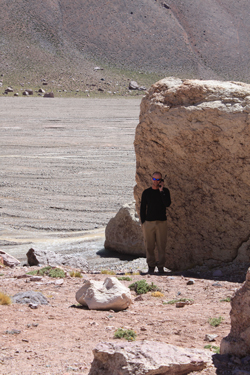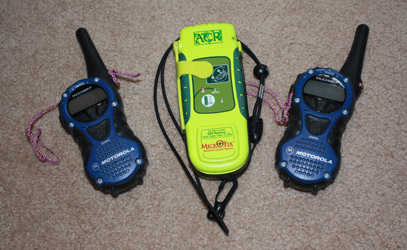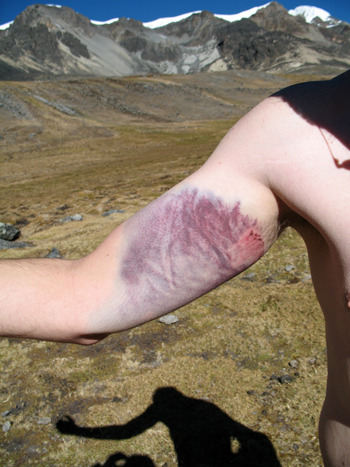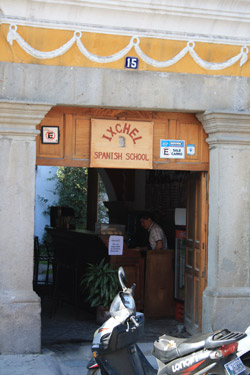|
|---|
Peru 2011Logistics III - Communications, Health, Language, MappingCommunications:
Due to the fact that we will be in a remote valley on this trip, the availability of a satellite telephone to make an occasional call home to the spouse, letting them know that we are on schedule and that all is well additionally justifies the rental. We call home using a nightly rotation, using about 3 minutes per call to let the home front know our location and that all are well. The spouse who gets the call then calls the others to relay the information. Good politics . . . Personal Locator Beacon. Another communication device that we took along was a GPS equipped personal locator beacon. While I can predict the response that a PLB will bring Portable Radios. We also took along a pair of Motorola walkie talkies so we could leave one at our camp and take one along as we climb. Alternatively, depending upon the state of the glacier, we put one on the front and back members of our rope team. During this trip we left one radio with our cook when we attempted Mariposa and then on another day when we split the group. we put one wiht G on one peak and Bob and I took the other on our climb. Health:
In addition to general meds that we may need on the trip, everyone generally had their tetanus, hepatitis, typhoid, flu, and other inoculations in order. I took the opportunity to make a quick visit to the family doctor to appraise her of the trip so that scripts for "just in case" meds to take along were just a phone call away. G and I also purchased evacuation insurnce from MedJet Assist, figuring we could handle the lcoal cost of getting fixed up enought to get put on a plane to Denver at the cost of an insurance carrier. The cost for a year of coverage for relocaiton from any point more than 150 miles from home was $250 and coverage for this trip only ran $150. A ridge for a severely screwed up person from Peru to the U.S. might otherwise run the better part of a year's pay, before taxes. Language:
I'll again throw in a plug for Ixchel Spanish School in Antigua while I'm at it. I took a two week course to improve the Spanish that I had from about four aggregate months of travel, a course or two at the community college and some opportunities to practice what I knew between trips with my Spanish speaking workforce during a thirteen month hitch with a past employer. G's Spanish comes from the Rosetta Stone course, one week in Antigua and listening to my efforts over six past trips. I give him a lot of credit, he is now putting the pieces together. Most importantly remember that a little bit of the lingo will go a long way with the locals . . . and you might even have fun in the process! Mapping:There is a 1:100,000 map of the Ausangate area (Ocangate "Quad") and I was able to construct a copy by visiting the library at the Colorado School of Mines. I'm an alum and had access to their map collection which fortunately includes the quad that we needed for this trip. I was able to make fractional copies (6 - 11x17 sheets for good overlap) that I then took home, scanned and stitched together using Photoshop to create a custom map of our climbing area. Once a full size map was constructed, I cropped sections that covered specific portions of the trip, mainly prospective climbs. These were sized to 8 1/2 x 11 and laminated so they could be carried along on the climbs and annotated as necessary. G was also able to secure an Ocangate map from a dealer that we ordinarily expect to fail to function, but in a first and obviously rare moment, they came through,literlaly delviering the map a day or so before our departure. If they can pull off a second consecutive custoemer service fete, I'll list their name in a future report. I also prepared a set of Google Earth shots, covering our approach, an oblique of the east and west sides of the valley we would be climbing in and an oblique of our route out of the valley to our departure trailhead. These photos were annotated with GPS points that, with the topography, would let us gauge progress on our approach and retreat as well as pick out substanitive topographic features for potential climbs. The final piece of the mapping puzzle was pre-programming a GPS unit with all of the photo waypoints, less necessary with an arriero but requried to cooridante our photo mapping effort.
Preparations
|

 Satellite Phone. As done before, we rented a satellite phone to give us a means to contact the logistics provider, home, or anyone else in the event of a change of plans or emergency. Our past trip re-shuffling methods have ranged from sending a runner to catch a collectivo ride to town and make contact with the logistics provider on an earlier Peru trip to the much more effective satellite phone call to the provider we used in Bolivia to confirm that we would arrive at trail's end on the agreed upon date.
Satellite Phone. As done before, we rented a satellite phone to give us a means to contact the logistics provider, home, or anyone else in the event of a change of plans or emergency. Our past trip re-shuffling methods have ranged from sending a runner to catch a collectivo ride to town and make contact with the logistics provider on an earlier Peru trip to the much more effective satellite phone call to the provider we used in Bolivia to confirm that we would arrive at trail's end on the agreed upon date.  in the States, I do not know of the response an alert might receive in Peru. However, better safe than sorry and, since we have a PLB as part of the group gear already, there is no harm in taking it along.
in the States, I do not know of the response an alert might receive in Peru. However, better safe than sorry and, since we have a PLB as part of the group gear already, there is no harm in taking it along. It never hurts to be prepared for the unexpected during the course of any climb, weekend or expedition. Given that G is a pharmacist by trade, he prepared a kit full of meds for the trip, covering everything from teeth to trots. In the past he has shut down all marine traffic on my alimentary canal, cured my Cheynes Stokes breathing at our high camps and expressed his admiration for the
It never hurts to be prepared for the unexpected during the course of any climb, weekend or expedition. Given that G is a pharmacist by trade, he prepared a kit full of meds for the trip, covering everything from teeth to trots. In the past he has shut down all marine traffic on my alimentary canal, cured my Cheynes Stokes breathing at our high camps and expressed his admiration for the  After six trips to South America to climb and other non climbing trips with my wife or another compadre, my Spanish is passable for getting around the climbing circuit. G and I both took a Spanish course in March of 2009 in Antigua, Guatemala, and that helped both of us to do a bit better talking to everyone from the taxi drivers to the camp cook. Most guide books and fellow travelers say that some knowledge is better than none and our experience is that no Spanish would make for a difficult trip. Our Spanish (and Spanglish) was just fine for our needs on this trip.
After six trips to South America to climb and other non climbing trips with my wife or another compadre, my Spanish is passable for getting around the climbing circuit. G and I both took a Spanish course in March of 2009 in Antigua, Guatemala, and that helped both of us to do a bit better talking to everyone from the taxi drivers to the camp cook. Most guide books and fellow travelers say that some knowledge is better than none and our experience is that no Spanish would make for a difficult trip. Our Spanish (and Spanglish) was just fine for our needs on this trip.